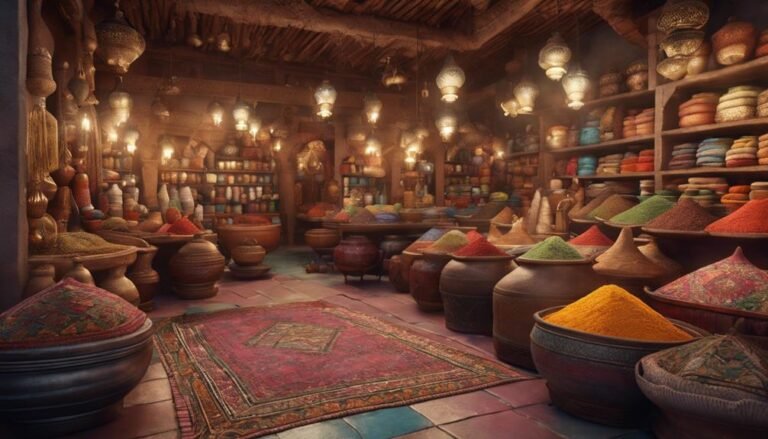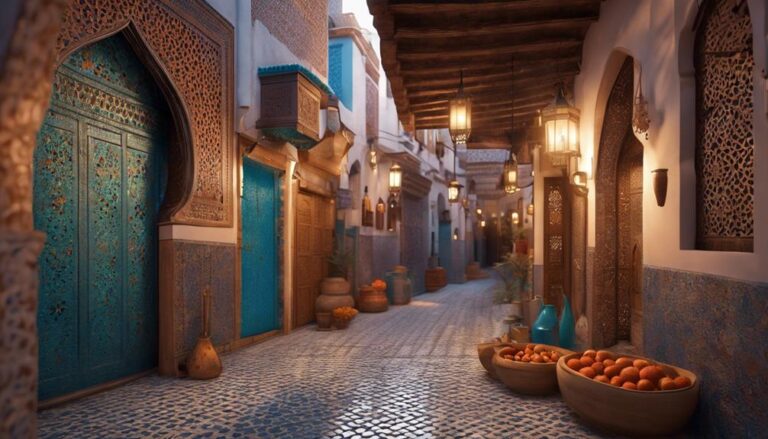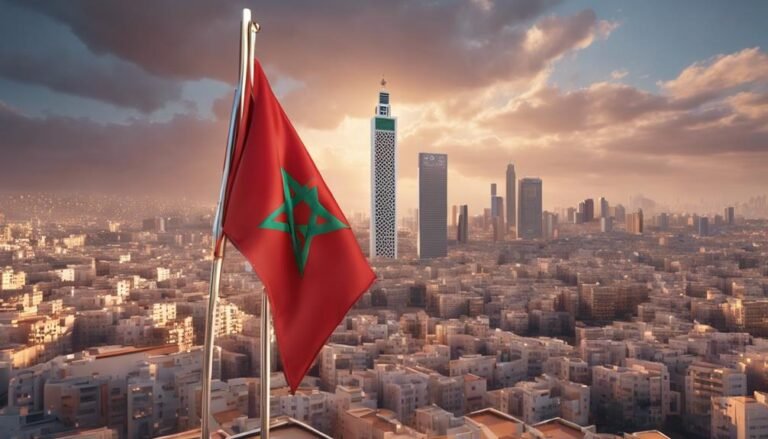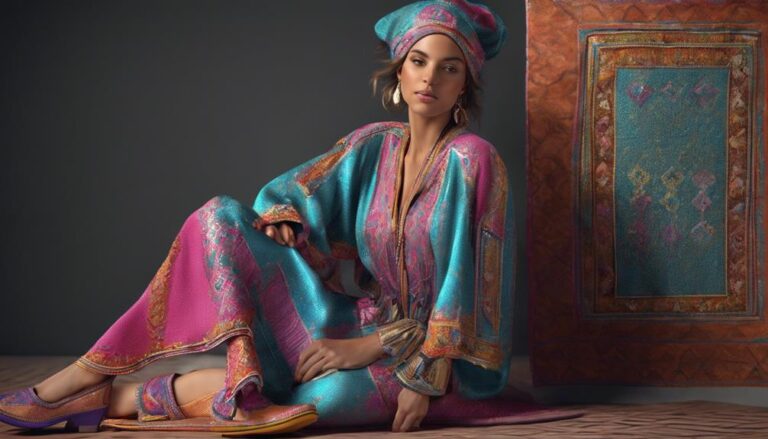Step into a riad, an architectural gem blending history and luxury. Experience a traditional Moroccan dwelling centered around a lush courtyard, showcasing intricate tile work and invigorating water features. Every corner resonates with vibrant textiles, ornate carvings, and mesmerizing mosaics, reflecting Morocco's rich craftsmanship. Riads offer an oasis of tranquility, merging modern comforts seamlessly with ancient design. Intrigued by the allure of Riads? Uncover more about their origin, unique features, and cultural significance.
Key Takeaways
- Riads are traditional Moroccan houses with a central courtyard.
- They feature intricate tile work, lush gardens, and ornate design elements.
- Riads were originally built for wealthy families as symbols of status.
- These properties offer a unique blend of cultural immersion and luxury.
- They play a significant role in preserving Moroccan architectural heritage.
Origin of Riads
Riads, originating in Morocco, are traditional houses or palaces built around a central courtyard. These stunning structures hold immense historical significance, dating back to the Roman Empire's rule over North Africa. The concept of riads evolved over centuries, influenced by various architectural styles from the Arabs, Berbers, and Moors.
Initially, riads were built as homes for the wealthy and noble families, showcasing intricate designs and luxurious amenities. Over time, they became symbols of status and prestige. The architectural evolution of riads saw the incorporation of elements like ornate tile work, carved wood, and elaborate archways, reflecting the rich cultural heritage of Morocco.
The historical significance of riads lies in their role as cultural hubs, where families gathered for celebrations, discussions, and relaxation. These structures served as private retreats from the bustling city life, offering a serene oasis in the heart of urban centers. Today, riads continue to captivate visitors with their timeless beauty and timeless charm, preserving a piece of Morocco's architectural history.
Architectural Features
As you learn more about riads, you'll discover their unique architectural features that set them apart.
The courtyards are central to the design, offering a tranquil oasis within the bustling city.
Decorative tiles and intricate patterns adorn the walls, while roof terraces provide stunning views of the surrounding area.
Courtyards Design
Nestled within the heart of a riad, the courtyards boast architectural features that blend traditional craftsmanship with intricate details, creating serene and enchanting spaces. Step into these tranquil sanctuaries, where every corner invites a sense of peace and relaxation.
Here are some elements that make riad courtyards truly special:
- Plant-filled oasis: Lush greenery surrounds you, creating a calming retreat that reconnects you with nature.
- Water feature: The gentle sounds of a fountain or a small pool add to the natural ambiance, offering a soothing backdrop to your stay.
- Architectural arches: Delicate archways frame the courtyards, adding a touch of elegance and traditional Moroccan charm to the design.
Immerse yourself in the beauty and tranquility of riad courtyards, where every detail showcases exquisite craftsmanship.
Decorative Tiles
Adorning the walls and floors of riads, decorative tiles serve as enchanting architectural features that infuse vibrant colors and intricate patterns into the design. These tiles are a reflection of Moroccan art, with their bold hues and striking designs that captivate the eye. Influenced by Andalusian artistry, the tiles often showcase elaborate geometric motifs and floral patterns, adding a touch of elegance and charm to the interior spaces of riads.
The vibrant colors, ranging from azure blues to fiery reds, create a sense of warmth and energy, while the intricate patterns mesmerize with their detailed craftsmanship. As you wander through a riad, the mesmerizing display of decorative tiles underfoot and on the walls transports you to a world where art and architecture intertwine seamlessly.
Roof Terraces
Upon reaching the rooftop of a riad, you're welcomed by the enchanting architectural features of the roof terraces. Here, you can indulge in the following:
- Sunset Views, Moroccan Style: Witness breathtaking sunsets over the cityscape in true Moroccan fashion, with vibrant colors painting the sky.
- Oasis Retreat: Escape the hustle and bustle of the city below as you relax in a serene oasis high above, surrounded by lush greenery and calming sounds.
- Urban Escape: Experience a tranquil retreat within the heart of the city, where you can unwind and rejuvenate while taking in the panoramic views of the bustling streets below.
Courtyard Design
In the heart of a riad, the courtyard design serves as the focal point, blending beauty with functionality to create a tranquil oasis. Courtyard landscaping plays a pivotal role in enhancing the aesthetic appeal of the space. Lush greenery, colorful flowers, and fragrant herbs are often incorporated, creating a peaceful retreat within the bustling city. Privacy walls surrounding the courtyard guarantee seclusion and intimacy, shielding the area from the outside world.
Fountain placement is another key feature in courtyard design, adding a soothing element with the gentle sound of flowing water. Fountains are strategically positioned to create a harmonious atmosphere, inviting you to relax and unwind. Seating areas scattered around the courtyard offer cozy nooks to enjoy a cup of mint tea or simply bask in the serene ambiance.
Traditional Decor Elements
Nestled within the courtyard's serene embrace, traditional decor elements in a riad transport you to a world of timeless beauty and cultural richness. The intricate details found in every corner of a riad truly capture the essence of Moroccan design. Here are some key elements that contribute to the unique charm of traditional riad decor:
- Colorful Textiles: From vibrant rugs to intricately woven tapestries, colorful textiles play an essential role in adding warmth and character to the space.
- Ornate Furnishings: Richly decorated furniture pieces, often adorned with intricate patterns and designs, are a staple in traditional riad decor, adding a touch of luxury to the surroundings.
- Intricate Mosaics and Carved Woodwork: The walls and floors of a riad are often adorned with stunning mosaics, showcasing elaborate geometric patterns and colorful tiles. Additionally, carved woodwork can be found in doors, windows, and furniture, showcasing the craftsmanship and attention to detail typical of Moroccan design.
Riads Vs. Dars
Comparison between riads and dars reveals distinct architectural features and cultural influences that differentiate these traditional Moroccan dwellings. Riads, characterized by their traditional design elements, often feature central courtyards with gardens or fountains, surrounded by rooms with intricately tiled floors and arched doorways. These spaces typically focus on creating a tranquil and authentic Moroccan experience, emphasizing traditional craftsmanship and historical significance.
On the other hand, dars represent a more contemporary approach to Moroccan living spaces. While still rooted in Moroccan architectural heritage, dars often blend traditional elements with modern amenities and design styles. This fusion creates a unique atmosphere that balances authenticity with luxury, offering a more upscale and polished experience compared to the rustic charm of riads. Dars may feature sleeker lines, minimalist décor, and a focus on comfort and convenience for the modern traveler.
Whether you prefer the traditional allure of riads or the modern comforts of dars, both offer a glimpse into Morocco's rich architectural history and cultural traditions.
Modern Riad Trends
Exploring the evolution of riads in modern times reveals intriguing trends reshaping traditional Moroccan architecture and hospitality experiences. In response to the changing needs and preferences of travelers, modern riads are incorporating contemporary design elements and sustainable practices, creating a harmonious blend of heritage and innovation.
Here are three key trends driving the transformation of riads:
- Blend of Traditional and Modern Design: Contemporary riads are embracing a fusion of traditional Moroccan architectural elements with modern design aesthetics, creating spaces that are both visually striking and functional.
- Integration of Sustainability Practices: Many modern riads are implementing eco-friendly initiatives such as water conservation systems, solar panels, and locally sourced materials to minimize their environmental impact and promote sustainable tourism.
- Technology Integration: To enhance guest experiences, modern riads are incorporating smart technology solutions such as keyless entry systems, automated temperature controls, and high-speed Wi-Fi, catering to the needs of tech-savvy travelers while maintaining the charm of the traditional riad setting.
Riads in Tourism
Riads in tourism offer travelers a unique opportunity to immerse themselves in the rich cultural heritage of Morocco while enjoying a personalized and luxurious accommodation experience. Riad accommodations, characterized by their traditional Moroccan architecture centered around a courtyard garden or pool, provide a tranquil oasis amidst the bustling streets of cities like Marrakech and Fez.
Staying in a riad allows you to experience the intricate tile work, carved wooden doors, and colorful textiles that are hallmarks of Moroccan design. The attention to detail and personalized service in these boutique accommodations create a sense of exclusivity and pampering for guests.
In terms of tourism impact, choosing to stay in a riad can positively contribute to local communities. Many riads are family-owned, supporting local businesses and providing employment opportunities within the community. By patronizing these establishments, travelers can directly benefit the people and economy of Morocco while enjoying a truly immersive cultural experience.
Cultural Significance
Indulge in the rich tapestry of Moroccan heritage woven into every corner of a riad, where cultural significance manifests through intricate architectural details and traditional design elements. Within these historic homes lie stories of cultural preservation and historical significance that have been carefully maintained over the years.
- Architectural Marvel: Riads showcase the exquisite craftsmanship of Moroccan artisans, with elements like geometric tile work, ornate wood carvings, and serene courtyard fountains that date back centuries.
- Traditional Design: The layout and décor of riads reflect the traditional Moroccan way of life, with rooms centered around a central courtyard, adorned with vibrant textiles, intricate metalwork, and lush greenery.
- Living History: Staying in a riad offers a unique opportunity to immerse yourself in the past, experiencing firsthand the traditions, rituals, and architectural styles that have stood the test of time in Moroccan culture.
Buying a Riad
Immerse yourself in the world of Moroccan heritage by considering the intricacies involved in purchasing a riad. Buying a riad can be a rewarding property investment, offering not only a piece of history but also a unique living experience.
When looking for a riad, keep in mind that many of these properties are centuries old, making renovation projects an essential part of the buying process.
Before diving into purchasing a riad, it's important to assess your budget and renovation capabilities. While some riads may require minor updates, others could be extensive renovation projects. Factor in costs for restoration, permits, and professional help if needed.
Researching the riad's location is also crucial as it can greatly impact the property's value and potential for rental income if you plan on using it as an investment.
Ultimately, buying a riad isn't just acquiring a property; it's embracing a piece of Moroccan culture and history. With the right mindset and preparation, owning a riad can be a fulfilling experience that offers both a sense of tradition and a promising investment opportunity.
Conclusion
As you wander through the intricate corridors of a riad, you're transported to a hidden oasis, a sanctuary in the heart of bustling cities.
Like a rare gem tucked away in a treasure trove, a riad is a true reflection of Moroccan culture and history.
It's a place where tradition meets modernity, where past and present intertwine seamlessly, creating a harmonious blend of beauty and tranquility.
Experience the magic of a riad for yourself and immerse in its timeless charm.

The Editorial Team is a passionate group of Morocco enthusiasts dedicated to sharing the beauty, culture, and wonders of this captivating country. With diverse backgrounds and a deep love for travel, we strive to bring you engaging and informative content that inspires your Moroccan adventures. From uncovering hidden gems and sharing local insights to exploring mouthwatering cuisine and showcasing the vibrant lifestyle, our team is committed to providing you with valuable resources and exciting stories that enhance your exploration of Morocco. Join us on this journey as we celebrate the rich heritage and unforgettable experiences that make Morocco truly special.







